Essay: Exploring Politics and Society in the Film 'Not Just a Game'
VerifiedAdded on 2023/06/12
|7
|1936
|282
Essay
AI Summary
This essay presents a critical analysis of the documentary 'Not Just a Game,' based on Dave Zirin’s book, which explores the pervasive influence of politics in American sports. The film examines the careers of athletes like Billie Jean King, Jackie Robinson, and Pat Tillman, highlighting issues such as sexism, homophobia, militarism, and racism within the sports community. The essay discusses how the documentary uses historical footage and interviews to reveal the forgotten stories of athletes who challenged power structures and fought for social justice. It further analyzes specific issues like gender discrimination, the underrepresentation of women in sports media, and the slow acceptance of homosexuality in sports. The role of militarism in sports culture, particularly in American football, is also scrutinized. While praising the documentary's intent, the essay points out gaps in its coverage of racism, suggesting a need for deeper exploration of individual experiences and solutions. Overall, the essay concludes that 'Not Just a Game' successfully portrays the interconnectedness of power, politics, and American sports, emphasizing the significant influence of sports on society and celebrating the athletes who strived for a more diverse and equitable sports community.
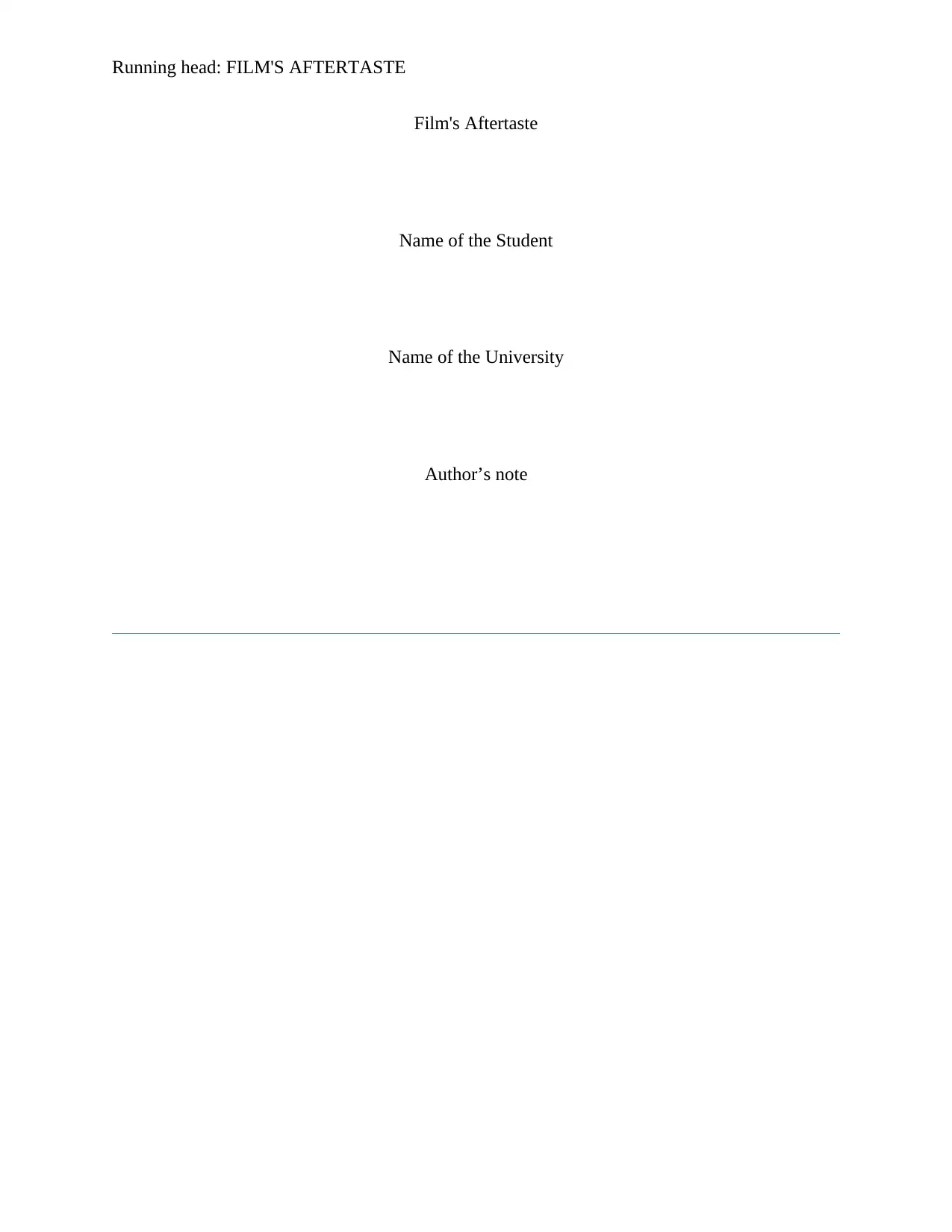
Running head: FILM'S AFTERTASTE
Film's Aftertaste
Name of the Student
Name of the University
Author’s note
Film's Aftertaste
Name of the Student
Name of the University
Author’s note
Paraphrase This Document
Need a fresh take? Get an instant paraphrase of this document with our AI Paraphraser
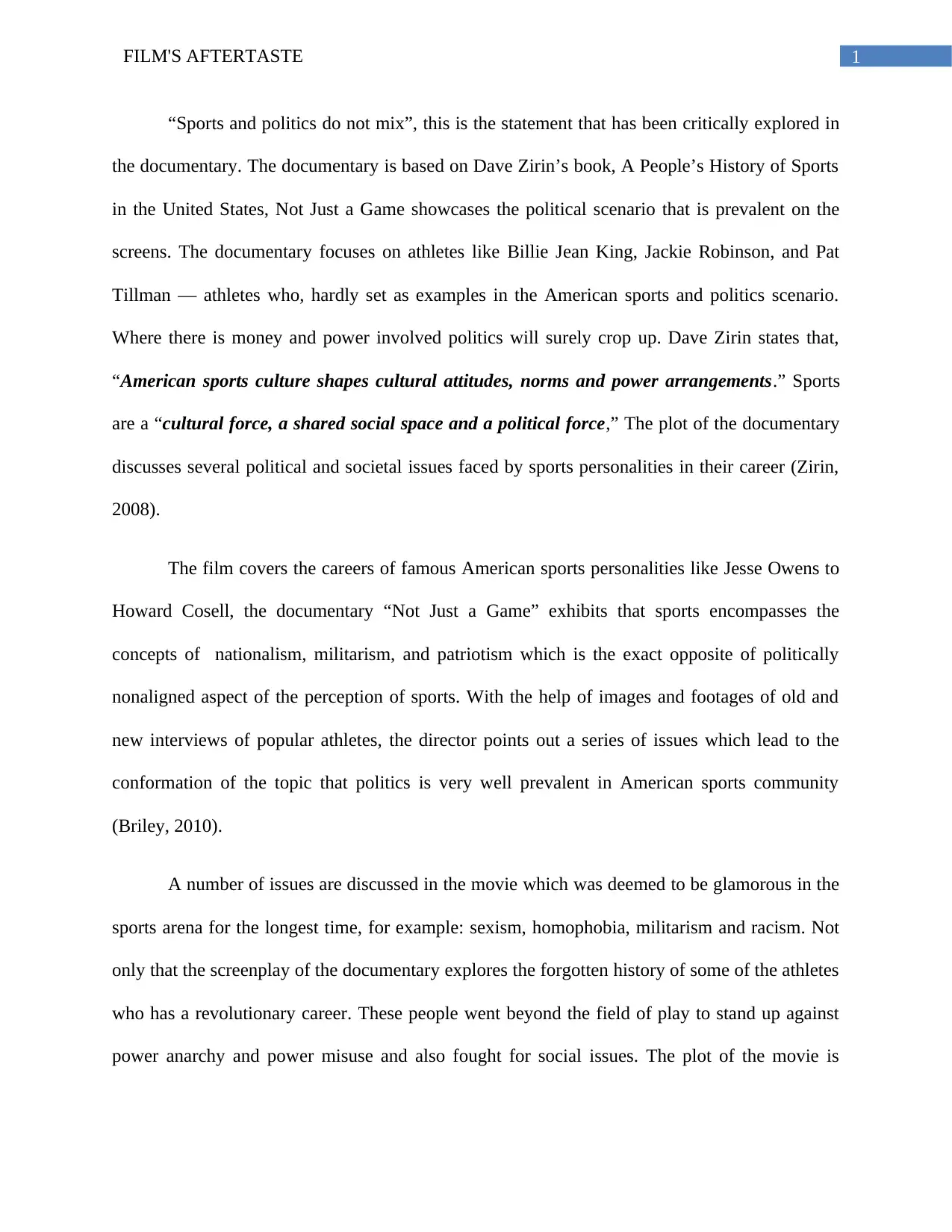
1FILM'S AFTERTASTE
“Sports and politics do not mix”, this is the statement that has been critically explored in
the documentary. The documentary is based on Dave Zirin’s book, A People’s History of Sports
in the United States, Not Just a Game showcases the political scenario that is prevalent on the
screens. The documentary focuses on athletes like Billie Jean King, Jackie Robinson, and Pat
Tillman — athletes who, hardly set as examples in the American sports and politics scenario.
Where there is money and power involved politics will surely crop up. Dave Zirin states that,
“American sports culture shapes cultural attitudes, norms and power arrangements.” Sports
are a “cultural force, a shared social space and a political force,” The plot of the documentary
discusses several political and societal issues faced by sports personalities in their career (Zirin,
2008).
The film covers the careers of famous American sports personalities like Jesse Owens to
Howard Cosell, the documentary “Not Just a Game” exhibits that sports encompasses the
concepts of nationalism, militarism, and patriotism which is the exact opposite of politically
nonaligned aspect of the perception of sports. With the help of images and footages of old and
new interviews of popular athletes, the director points out a series of issues which lead to the
conformation of the topic that politics is very well prevalent in American sports community
(Briley, 2010).
A number of issues are discussed in the movie which was deemed to be glamorous in the
sports arena for the longest time, for example: sexism, homophobia, militarism and racism. Not
only that the screenplay of the documentary explores the forgotten history of some of the athletes
who has a revolutionary career. These people went beyond the field of play to stand up against
power anarchy and power misuse and also fought for social issues. The plot of the movie is
“Sports and politics do not mix”, this is the statement that has been critically explored in
the documentary. The documentary is based on Dave Zirin’s book, A People’s History of Sports
in the United States, Not Just a Game showcases the political scenario that is prevalent on the
screens. The documentary focuses on athletes like Billie Jean King, Jackie Robinson, and Pat
Tillman — athletes who, hardly set as examples in the American sports and politics scenario.
Where there is money and power involved politics will surely crop up. Dave Zirin states that,
“American sports culture shapes cultural attitudes, norms and power arrangements.” Sports
are a “cultural force, a shared social space and a political force,” The plot of the documentary
discusses several political and societal issues faced by sports personalities in their career (Zirin,
2008).
The film covers the careers of famous American sports personalities like Jesse Owens to
Howard Cosell, the documentary “Not Just a Game” exhibits that sports encompasses the
concepts of nationalism, militarism, and patriotism which is the exact opposite of politically
nonaligned aspect of the perception of sports. With the help of images and footages of old and
new interviews of popular athletes, the director points out a series of issues which lead to the
conformation of the topic that politics is very well prevalent in American sports community
(Briley, 2010).
A number of issues are discussed in the movie which was deemed to be glamorous in the
sports arena for the longest time, for example: sexism, homophobia, militarism and racism. Not
only that the screenplay of the documentary explores the forgotten history of some of the athletes
who has a revolutionary career. These people went beyond the field of play to stand up against
power anarchy and power misuse and also fought for social issues. The plot of the movie is
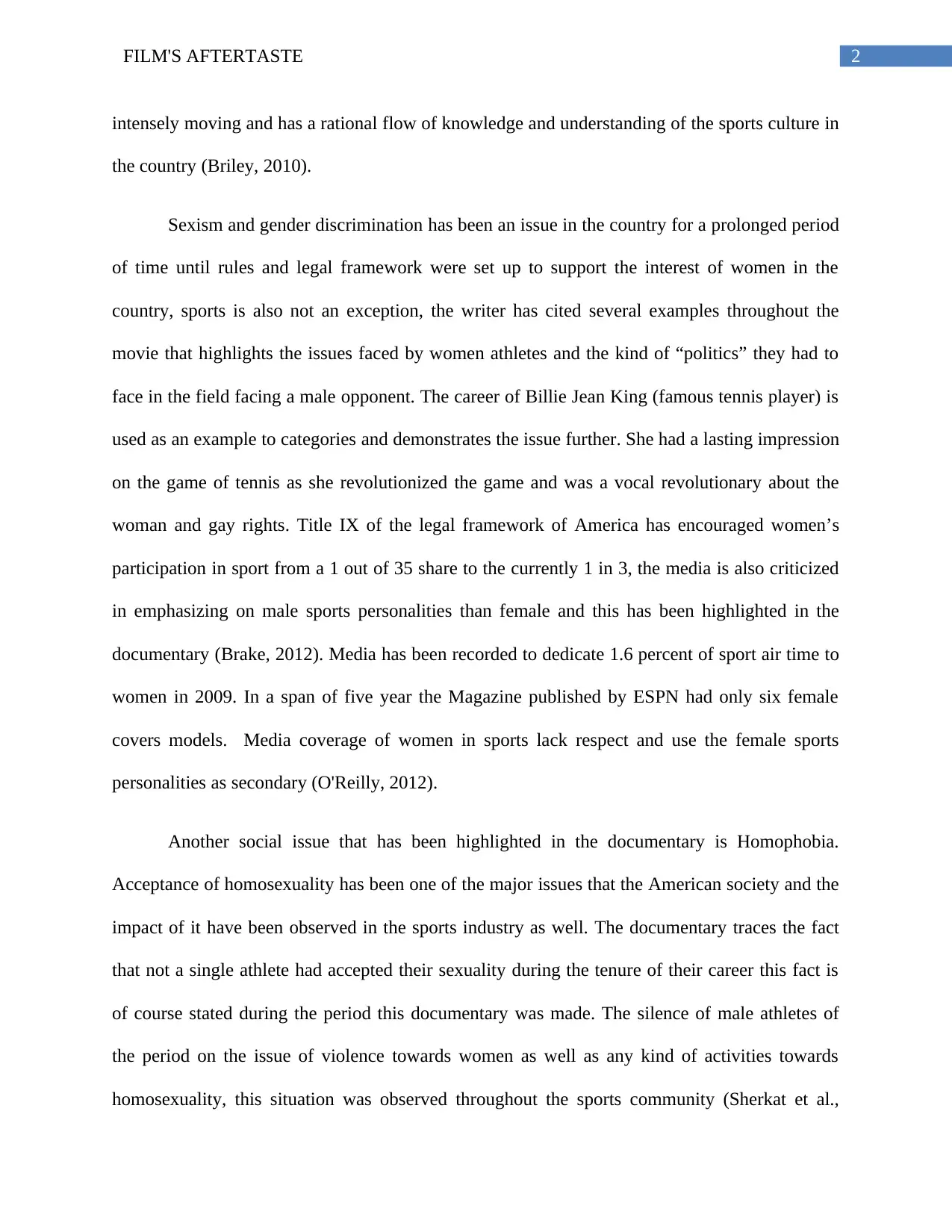
2FILM'S AFTERTASTE
intensely moving and has a rational flow of knowledge and understanding of the sports culture in
the country (Briley, 2010).
Sexism and gender discrimination has been an issue in the country for a prolonged period
of time until rules and legal framework were set up to support the interest of women in the
country, sports is also not an exception, the writer has cited several examples throughout the
movie that highlights the issues faced by women athletes and the kind of “politics” they had to
face in the field facing a male opponent. The career of Billie Jean King (famous tennis player) is
used as an example to categories and demonstrates the issue further. She had a lasting impression
on the game of tennis as she revolutionized the game and was a vocal revolutionary about the
woman and gay rights. Title IX of the legal framework of America has encouraged women’s
participation in sport from a 1 out of 35 share to the currently 1 in 3, the media is also criticized
in emphasizing on male sports personalities than female and this has been highlighted in the
documentary (Brake, 2012). Media has been recorded to dedicate 1.6 percent of sport air time to
women in 2009. In a span of five year the Magazine published by ESPN had only six female
covers models. Media coverage of women in sports lack respect and use the female sports
personalities as secondary (O'Reilly, 2012).
Another social issue that has been highlighted in the documentary is Homophobia.
Acceptance of homosexuality has been one of the major issues that the American society and the
impact of it have been observed in the sports industry as well. The documentary traces the fact
that not a single athlete had accepted their sexuality during the tenure of their career this fact is
of course stated during the period this documentary was made. The silence of male athletes of
the period on the issue of violence towards women as well as any kind of activities towards
homosexuality, this situation was observed throughout the sports community (Sherkat et al.,
intensely moving and has a rational flow of knowledge and understanding of the sports culture in
the country (Briley, 2010).
Sexism and gender discrimination has been an issue in the country for a prolonged period
of time until rules and legal framework were set up to support the interest of women in the
country, sports is also not an exception, the writer has cited several examples throughout the
movie that highlights the issues faced by women athletes and the kind of “politics” they had to
face in the field facing a male opponent. The career of Billie Jean King (famous tennis player) is
used as an example to categories and demonstrates the issue further. She had a lasting impression
on the game of tennis as she revolutionized the game and was a vocal revolutionary about the
woman and gay rights. Title IX of the legal framework of America has encouraged women’s
participation in sport from a 1 out of 35 share to the currently 1 in 3, the media is also criticized
in emphasizing on male sports personalities than female and this has been highlighted in the
documentary (Brake, 2012). Media has been recorded to dedicate 1.6 percent of sport air time to
women in 2009. In a span of five year the Magazine published by ESPN had only six female
covers models. Media coverage of women in sports lack respect and use the female sports
personalities as secondary (O'Reilly, 2012).
Another social issue that has been highlighted in the documentary is Homophobia.
Acceptance of homosexuality has been one of the major issues that the American society and the
impact of it have been observed in the sports industry as well. The documentary traces the fact
that not a single athlete had accepted their sexuality during the tenure of their career this fact is
of course stated during the period this documentary was made. The silence of male athletes of
the period on the issue of violence towards women as well as any kind of activities towards
homosexuality, this situation was observed throughout the sports community (Sherkat et al.,
⊘ This is a preview!⊘
Do you want full access?
Subscribe today to unlock all pages.

Trusted by 1+ million students worldwide
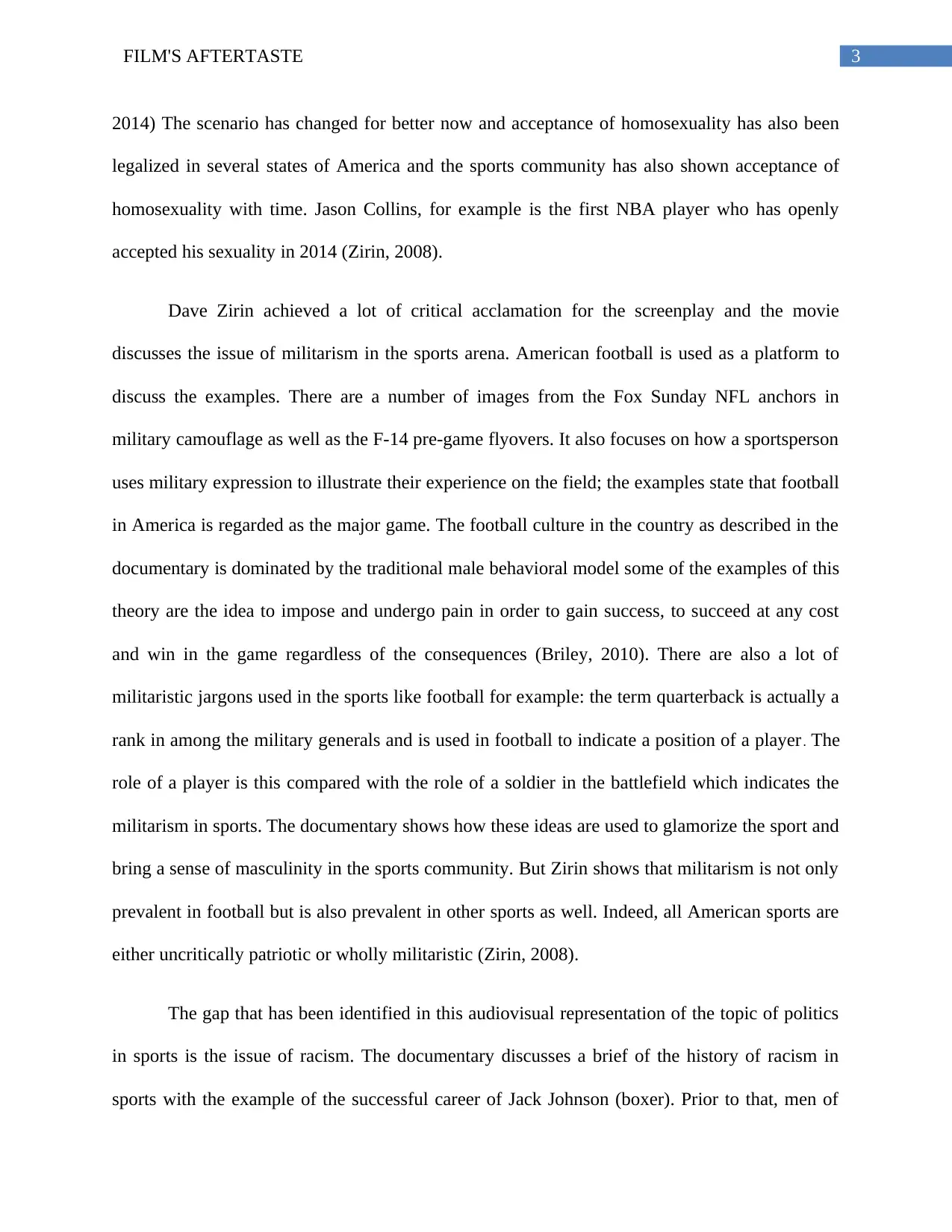
3FILM'S AFTERTASTE
2014) The scenario has changed for better now and acceptance of homosexuality has also been
legalized in several states of America and the sports community has also shown acceptance of
homosexuality with time. Jason Collins, for example is the first NBA player who has openly
accepted his sexuality in 2014 (Zirin, 2008).
Dave Zirin achieved a lot of critical acclamation for the screenplay and the movie
discusses the issue of militarism in the sports arena. American football is used as a platform to
discuss the examples. There are a number of images from the Fox Sunday NFL anchors in
military camouflage as well as the F-14 pre-game flyovers. It also focuses on how a sportsperson
uses military expression to illustrate their experience on the field; the examples state that football
in America is regarded as the major game. The football culture in the country as described in the
documentary is dominated by the traditional male behavioral model some of the examples of this
theory are the idea to impose and undergo pain in order to gain success, to succeed at any cost
and win in the game regardless of the consequences (Briley, 2010). There are also a lot of
militaristic jargons used in the sports like football for example: the term quarterback is actually a
rank in among the military generals and is used in football to indicate a position of a player. The
role of a player is this compared with the role of a soldier in the battlefield which indicates the
militarism in sports. The documentary shows how these ideas are used to glamorize the sport and
bring a sense of masculinity in the sports community. But Zirin shows that militarism is not only
prevalent in football but is also prevalent in other sports as well. Indeed, all American sports are
either uncritically patriotic or wholly militaristic (Zirin, 2008).
The gap that has been identified in this audiovisual representation of the topic of politics
in sports is the issue of racism. The documentary discusses a brief of the history of racism in
sports with the example of the successful career of Jack Johnson (boxer). Prior to that, men of
2014) The scenario has changed for better now and acceptance of homosexuality has also been
legalized in several states of America and the sports community has also shown acceptance of
homosexuality with time. Jason Collins, for example is the first NBA player who has openly
accepted his sexuality in 2014 (Zirin, 2008).
Dave Zirin achieved a lot of critical acclamation for the screenplay and the movie
discusses the issue of militarism in the sports arena. American football is used as a platform to
discuss the examples. There are a number of images from the Fox Sunday NFL anchors in
military camouflage as well as the F-14 pre-game flyovers. It also focuses on how a sportsperson
uses military expression to illustrate their experience on the field; the examples state that football
in America is regarded as the major game. The football culture in the country as described in the
documentary is dominated by the traditional male behavioral model some of the examples of this
theory are the idea to impose and undergo pain in order to gain success, to succeed at any cost
and win in the game regardless of the consequences (Briley, 2010). There are also a lot of
militaristic jargons used in the sports like football for example: the term quarterback is actually a
rank in among the military generals and is used in football to indicate a position of a player. The
role of a player is this compared with the role of a soldier in the battlefield which indicates the
militarism in sports. The documentary shows how these ideas are used to glamorize the sport and
bring a sense of masculinity in the sports community. But Zirin shows that militarism is not only
prevalent in football but is also prevalent in other sports as well. Indeed, all American sports are
either uncritically patriotic or wholly militaristic (Zirin, 2008).
The gap that has been identified in this audiovisual representation of the topic of politics
in sports is the issue of racism. The documentary discusses a brief of the history of racism in
sports with the example of the successful career of Jack Johnson (boxer). Prior to that, men of
Paraphrase This Document
Need a fresh take? Get an instant paraphrase of this document with our AI Paraphraser
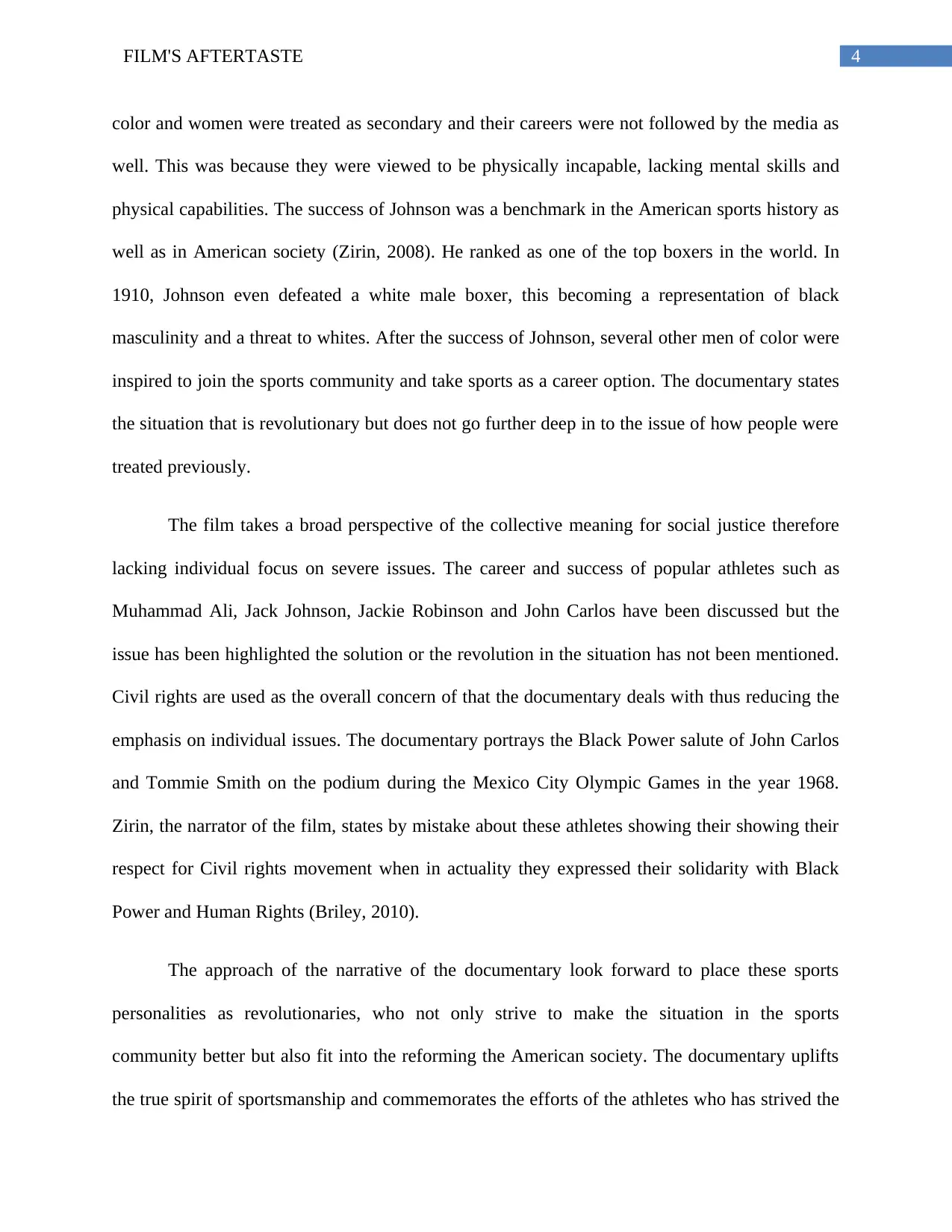
4FILM'S AFTERTASTE
color and women were treated as secondary and their careers were not followed by the media as
well. This was because they were viewed to be physically incapable, lacking mental skills and
physical capabilities. The success of Johnson was a benchmark in the American sports history as
well as in American society (Zirin, 2008). He ranked as one of the top boxers in the world. In
1910, Johnson even defeated a white male boxer, this becoming a representation of black
masculinity and a threat to whites. After the success of Johnson, several other men of color were
inspired to join the sports community and take sports as a career option. The documentary states
the situation that is revolutionary but does not go further deep in to the issue of how people were
treated previously.
The film takes a broad perspective of the collective meaning for social justice therefore
lacking individual focus on severe issues. The career and success of popular athletes such as
Muhammad Ali, Jack Johnson, Jackie Robinson and John Carlos have been discussed but the
issue has been highlighted the solution or the revolution in the situation has not been mentioned.
Civil rights are used as the overall concern of that the documentary deals with thus reducing the
emphasis on individual issues. The documentary portrays the Black Power salute of John Carlos
and Tommie Smith on the podium during the Mexico City Olympic Games in the year 1968.
Zirin, the narrator of the film, states by mistake about these athletes showing their showing their
respect for Civil rights movement when in actuality they expressed their solidarity with Black
Power and Human Rights (Briley, 2010).
The approach of the narrative of the documentary look forward to place these sports
personalities as revolutionaries, who not only strive to make the situation in the sports
community better but also fit into the reforming the American society. The documentary uplifts
the true spirit of sportsmanship and commemorates the efforts of the athletes who has strived the
color and women were treated as secondary and their careers were not followed by the media as
well. This was because they were viewed to be physically incapable, lacking mental skills and
physical capabilities. The success of Johnson was a benchmark in the American sports history as
well as in American society (Zirin, 2008). He ranked as one of the top boxers in the world. In
1910, Johnson even defeated a white male boxer, this becoming a representation of black
masculinity and a threat to whites. After the success of Johnson, several other men of color were
inspired to join the sports community and take sports as a career option. The documentary states
the situation that is revolutionary but does not go further deep in to the issue of how people were
treated previously.
The film takes a broad perspective of the collective meaning for social justice therefore
lacking individual focus on severe issues. The career and success of popular athletes such as
Muhammad Ali, Jack Johnson, Jackie Robinson and John Carlos have been discussed but the
issue has been highlighted the solution or the revolution in the situation has not been mentioned.
Civil rights are used as the overall concern of that the documentary deals with thus reducing the
emphasis on individual issues. The documentary portrays the Black Power salute of John Carlos
and Tommie Smith on the podium during the Mexico City Olympic Games in the year 1968.
Zirin, the narrator of the film, states by mistake about these athletes showing their showing their
respect for Civil rights movement when in actuality they expressed their solidarity with Black
Power and Human Rights (Briley, 2010).
The approach of the narrative of the documentary look forward to place these sports
personalities as revolutionaries, who not only strive to make the situation in the sports
community better but also fit into the reforming the American society. The documentary uplifts
the true spirit of sportsmanship and commemorates the efforts of the athletes who has strived the
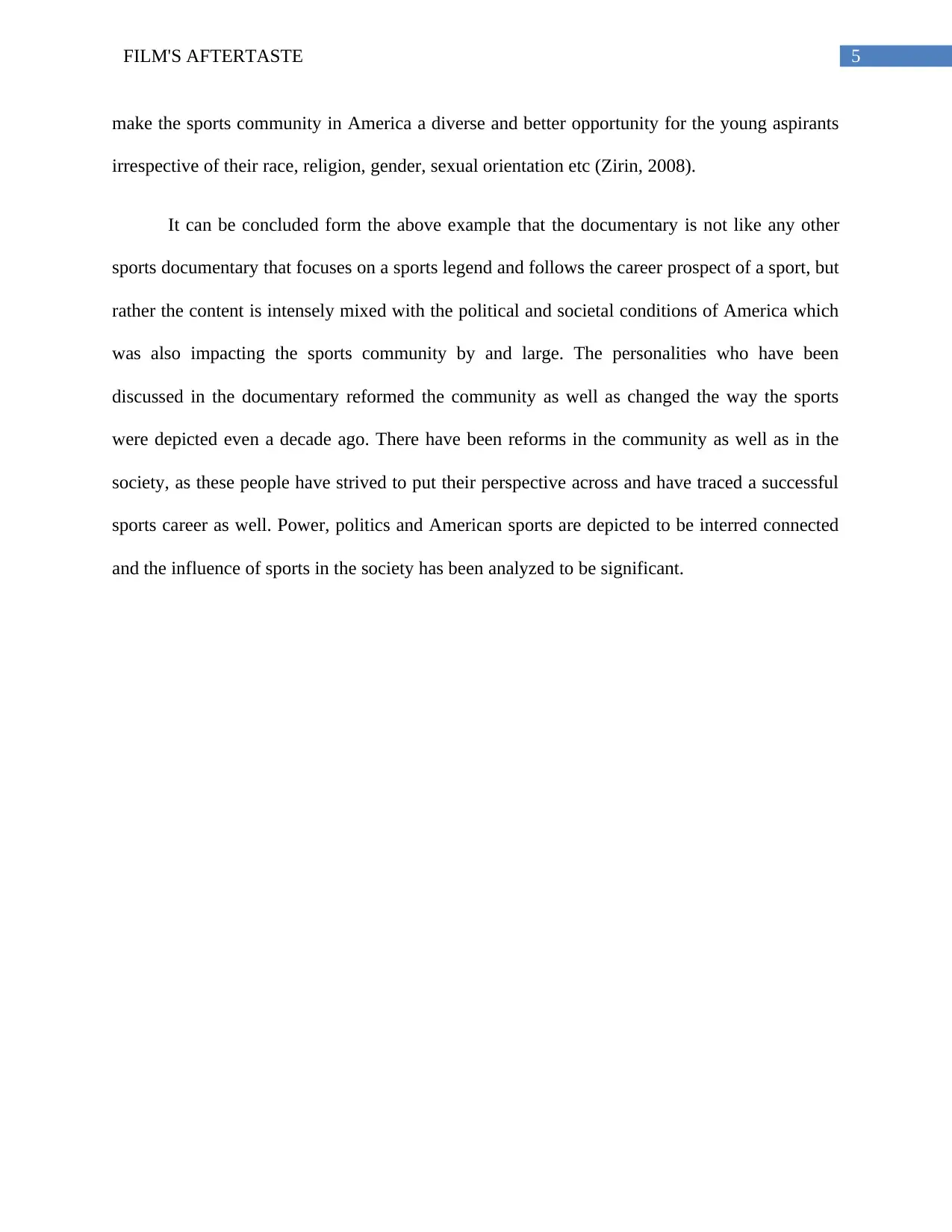
5FILM'S AFTERTASTE
make the sports community in America a diverse and better opportunity for the young aspirants
irrespective of their race, religion, gender, sexual orientation etc (Zirin, 2008).
It can be concluded form the above example that the documentary is not like any other
sports documentary that focuses on a sports legend and follows the career prospect of a sport, but
rather the content is intensely mixed with the political and societal conditions of America which
was also impacting the sports community by and large. The personalities who have been
discussed in the documentary reformed the community as well as changed the way the sports
were depicted even a decade ago. There have been reforms in the community as well as in the
society, as these people have strived to put their perspective across and have traced a successful
sports career as well. Power, politics and American sports are depicted to be interred connected
and the influence of sports in the society has been analyzed to be significant.
make the sports community in America a diverse and better opportunity for the young aspirants
irrespective of their race, religion, gender, sexual orientation etc (Zirin, 2008).
It can be concluded form the above example that the documentary is not like any other
sports documentary that focuses on a sports legend and follows the career prospect of a sport, but
rather the content is intensely mixed with the political and societal conditions of America which
was also impacting the sports community by and large. The personalities who have been
discussed in the documentary reformed the community as well as changed the way the sports
were depicted even a decade ago. There have been reforms in the community as well as in the
society, as these people have strived to put their perspective across and have traced a successful
sports career as well. Power, politics and American sports are depicted to be interred connected
and the influence of sports in the society has been analyzed to be significant.
⊘ This is a preview!⊘
Do you want full access?
Subscribe today to unlock all pages.

Trusted by 1+ million students worldwide
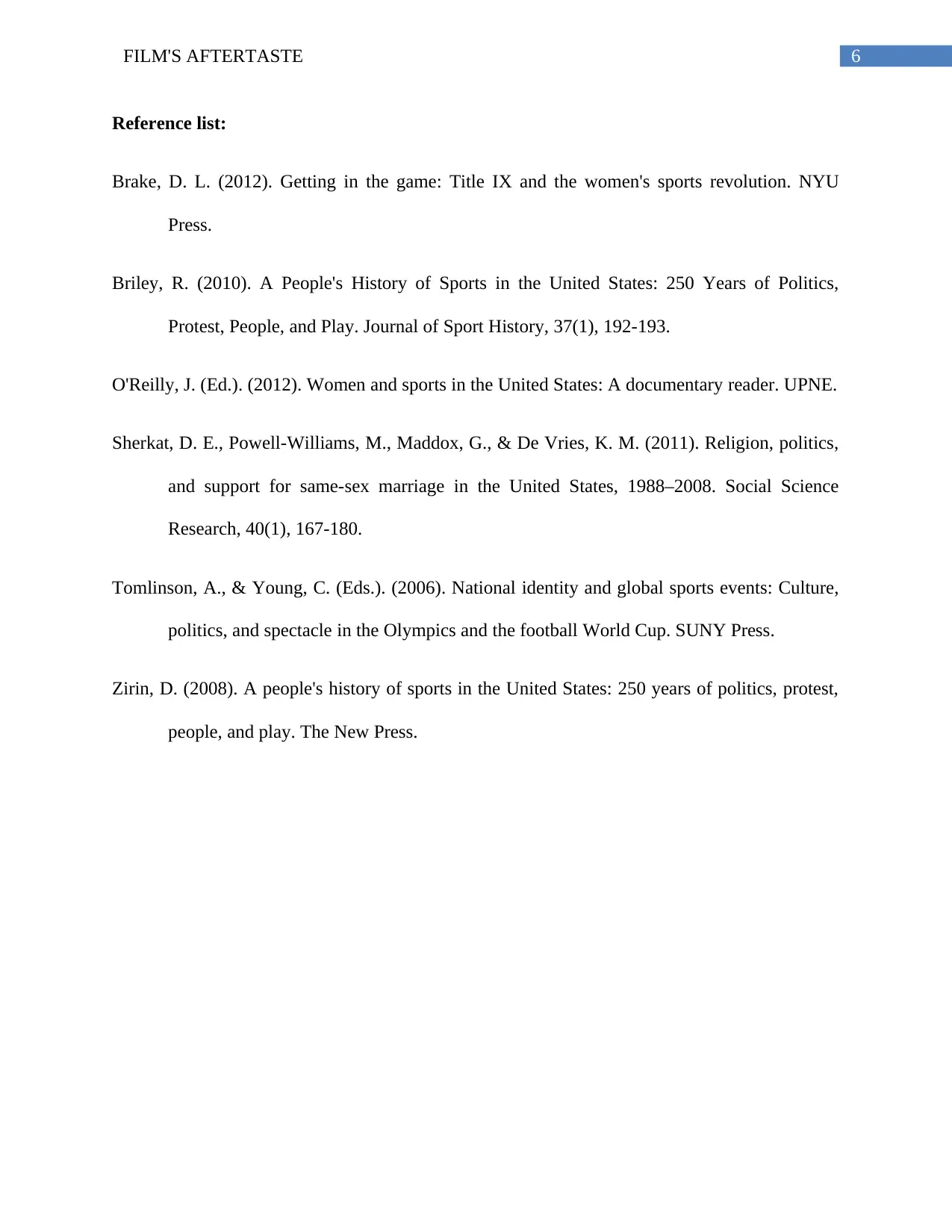
6FILM'S AFTERTASTE
Reference list:
Brake, D. L. (2012). Getting in the game: Title IX and the women's sports revolution. NYU
Press.
Briley, R. (2010). A People's History of Sports in the United States: 250 Years of Politics,
Protest, People, and Play. Journal of Sport History, 37(1), 192-193.
O'Reilly, J. (Ed.). (2012). Women and sports in the United States: A documentary reader. UPNE.
Sherkat, D. E., Powell-Williams, M., Maddox, G., & De Vries, K. M. (2011). Religion, politics,
and support for same-sex marriage in the United States, 1988–2008. Social Science
Research, 40(1), 167-180.
Tomlinson, A., & Young, C. (Eds.). (2006). National identity and global sports events: Culture,
politics, and spectacle in the Olympics and the football World Cup. SUNY Press.
Zirin, D. (2008). A people's history of sports in the United States: 250 years of politics, protest,
people, and play. The New Press.
Reference list:
Brake, D. L. (2012). Getting in the game: Title IX and the women's sports revolution. NYU
Press.
Briley, R. (2010). A People's History of Sports in the United States: 250 Years of Politics,
Protest, People, and Play. Journal of Sport History, 37(1), 192-193.
O'Reilly, J. (Ed.). (2012). Women and sports in the United States: A documentary reader. UPNE.
Sherkat, D. E., Powell-Williams, M., Maddox, G., & De Vries, K. M. (2011). Religion, politics,
and support for same-sex marriage in the United States, 1988–2008. Social Science
Research, 40(1), 167-180.
Tomlinson, A., & Young, C. (Eds.). (2006). National identity and global sports events: Culture,
politics, and spectacle in the Olympics and the football World Cup. SUNY Press.
Zirin, D. (2008). A people's history of sports in the United States: 250 years of politics, protest,
people, and play. The New Press.
1 out of 7
Your All-in-One AI-Powered Toolkit for Academic Success.
+13062052269
info@desklib.com
Available 24*7 on WhatsApp / Email
![[object Object]](/_next/static/media/star-bottom.7253800d.svg)
Unlock your academic potential
Copyright © 2020–2025 A2Z Services. All Rights Reserved. Developed and managed by ZUCOL.